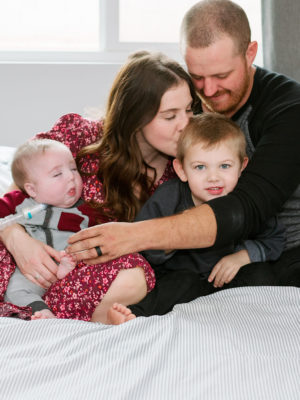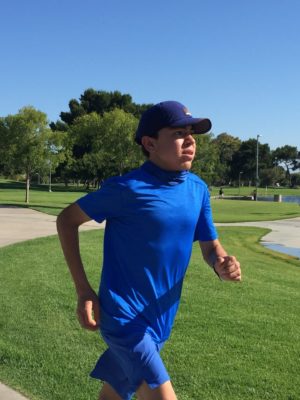The symptoms and treatment of Neurofibromatosis type 1
Jax Mincks, 4, asks her parents to turn on one of her favorite animated TV shows, “Bluey,” whose main character is an Australian cattle puppy characterized by her abundance of energy, imagination, and curiosity.
The same could be said of Jax, a little pistol who also is hilarious and kind-hearted, say her parents, Jessica and Matt.
Jax is one of those rare children diagnosed with neurofibromatosis type 1 (NF1), a common genetic condition that primarily affects the skin and the nervous system, whose disease developed into a serious medical issue.
Were it not for the cutting-edge care Jax has and continues to receive at CHOC, things could even be worse, her parents say.
Jax hasn’t let the loss of sight in one eye slow her down or change any of her behaviors. And her parents take pride in not treating her any differently from her sister, Elleni, 6, or other children.

They credit the multidisciplinary care offered through CHOC’s Neurofibromatosis Program for making Jax’s medical odyssey go as smoothly as possible.
“She has taught us the true meaning of resilience,” Matt says. “You would have no idea how much this little girl has gone through.”
A multidisciplinary approach
CHOC’s Neurofibromatosis Program has been treating children with NF1 for more than 30 years and annually cares for around 150 children with the disorder.
The program became a multidisciplinary clinic in 2014, and the following year it became an affiliated clinic with the Children’s Tumor Foundation, making CHOC a possible future NF1 clinical trial site.
“Within the last five years, we’ve really developed the multidisciplinary side of the clinic,” says Dr. Neda Zadeh, a CHOC medical geneticist and director of the NF Program at CHOC.
More than a dozen CHOC specialists in genetics, oncology, orthopedics, neurology, ophthalmology, and neurosurgery make up the NF1 team.
“Every month, we meet as a team and see patients together,” Dr. Zadeh says. “We review the history of each patient before we go into the room, review imaging, review recommendations, and then we go together to see each patient as a team. We collectively answer questions and devise a medical plan. It’s one visit with all the providers the patient typically needs.”
Harmless birthmarks?
Jax was born with a few café au lait spots around her stomach area and armpits. These flat, hyperpigmented spots whose light-brown color earned them the name “coffee with milk” in French are one of seven symptoms for a possible NF1 diagnosis.
The Minckses had never heard of NF1, and thought the spots were harmless birthmarks.
At 6 months, Jax developed freckling and at 9 months, her pediatrician referred her to CHOC to see Dr. Zadeh to confirm or rule out NF1. Dr. Zadeh did a full workup on Jax, and continued to monitor her carefully, but as this is a condition that evolves over time, she was not formally diagnosed with NF1 until April 2018.
Learn the signs and symptoms of NF1 and when you should seek treatment for your child.
In May 2019, CHOC ophthalmologist Dr. Rahul Bhola, medical director of the ophthalmology department, noticed optic nerve swelling in Jax during a clinical exam. He ordered an urgent MRI to assess her brain and eyes to rule out an optic nerve glioma.
Subsequently, Jax was sent to UCLA to see prominent pediatric neuro-ophthalmologist Dr. Stacy Pineles, residency program director at the Stein Eye Institute at the David Geffen School of Medicine at the University of California, Los Angeles.
Dr. Pineles began co-managing Jax’s case with CHOC pediatric neuro-oncologist Dr. Chenue Abongwa. Jax had Lisch nodules on her eyes – another symptom on the list of seven. If a child has just two of these seven symptoms, a diagnosis of NF1 can be made clinically.
NF1 occurs in about one in every 3,000 children, and most of these children do very well and do not develop issues, Dr. Zadeh says.
But in about 1% of NF1 cases, the condition can lead to tumors in the brain, neck, other areas, or in the eyes.
Jax suffered the latter fate.
However, her eyesight remained fine.
“It was a weird wait-and-see game,” Jessica says.
A change in chemo regimen
In December 2019, an MRI showed the tumors in Jax’s eyes had dramatically grown, especially in her right eye.
Within two weeks, Jax began chemotherapy treatment.

“Jax was a unique case,” Jessica says. “Her eyesight was perfect in both eyes, but we decided to go ahead with chemotherapy treatment.”
Six weeks later, Jax lost vision in her right eye. But after 58 weeks of weekly infusions that ended in February 2021, the tumors had shrunk and were stable, Matt says.
A key turning point in Jax’s care came three months after her chemotherapy treatment ended. Swelling and tumor growth had returned. Jax remained on Avastin, an anti-inflammatory medication, but Dr. Abongwa took her off the chemotherapy drug Vinblastin and put her on Trametinib, which has been approved for treating melanoma, thyroid cancer, and a type of lung cancer.
Because Trametinib has yet to be approved for optical tumors, CHOC had to secure compassionate use approval for the medication.
In addition, the CHOC Research Institute was able to secure approval from the drug’s manufacturer to supply Trametinib at no cost to the Minckses after their insurance denied it since the drug was not formally approved for optical tumors.
“This is just one example of how amazing CHOC is,” Jessica says.
Indeed, says Dr. Zadeh, CHOC NF1 specialists currently are involved in cutting-edge clinical trials that are not available at many pediatric centers.
Lifelong treatment
An NF1 diagnosis requires lifelong treatment from a multidisciplinary team in case things turn south as they did with Jax.
She will see her geneticist and eye doctor yearly. In addition, Jax undergoes an MRI every three months. And she sees her neuro-ophthalmologist every six weeks and meets with her oncologist monthly.
Typically, children with NF1 can see some level of tumor growth up until the age of 8.
Sadly, Jax’s most recent MRI, on Aug. 16, 2021, showed that the tumor in her left eye is growing. Her CHOC care team is working with Dr. Pineles at UCLA to come up with the next treatment steps.
“It’s been quite the journey,” Jessica says. “And CHOC has been such a fabulous organization. The nurses and doctors who work there are incredible humans. They made everything seem so light even though it’s heavy.”
The Minckses had sought care for Jax at another pediatric hospital before they ended up at CHOC.
“It’s been an eye-opening experience to me how great we have it at CHOC,” Jessica says.
Matt says that through it all, Jax has been “tougher than nails.”
He adds: “She doesn’t cry or whine and rolls with it well. When you’re 4 years old you’re resilient and don’t know any different. She takes it in stride really well.”
Jax spends a lot of time playing with Coral, the family’s goldendoodle.
”She named her after a coral reef,” Jessica says. “We were at the beach. Her first choice was Sand Bucket.”
Dr. Zadeh says of the 150 or so NF1 patients CHOC sees every year, the multidisciplinary team is directly involved in 40-45 cases that require more specialist care.
“I couldn’t take care of all of Jax’s medical needs by myself,” Dr. Zadeh says. “If we didn’t have all these specialists willing to collaborate so closely and be in the same room, it would affect total patient care in a negative way. When kids have this rare and complex of a disease, you need to have all these brains in the same room together with the patient and the family to give Jax the best potential possible.”
Signs and symptoms of NF1
In order to meet criteria for an NF1 diagnosis, patients must meet two of the following criteria established by the National Institutes of Health (NIH), summarized below:
- Six or more café-au-lait macules of a specific measured diameter
- Two or more neurofibromas or one plexiform neurofibroma
- Freckling in the axillary or inguinal regions
- Optic glioma
- Two or more Lisch nodules on dilated eye exam
- A distinctive bony lesion
- A first-degree relative (parent, sibling, or offspring) with a known diagnosis of NF1.
If you think your child might be exhibiting signs and symptoms of NF1, or there is a family history of this genetic condition, speak with your pediatrician, who will perform an evaluation and may refer you to a geneticist for further examination and information.
For more health and wellness resources from the pediatric experts at CHOC, sign up for the Kids Health newsletter.
Find a CHOC Primary Care Pediatrician
From babies to teens, pediatricians from CHOC’s Primary Care Network partner with parents to offer immunizations, sick visits, sports physicals and more.





